Benchmark 1:
#HeForShe Campaign
Ever since Emma Watson became the main spokeswoman for the United Nations He For She Campaign I became fairly interested in their work as an organization. In all honestly I didn’t really know too much about the campaign thought it was a very large feminist movement. But that is not what it is at all the campaign is not designed to empower women to gain for equality in places or spaces that are not but for boys and men to be promoters as well. This campaign doesn’t make it women versus the world but men and women working together to end inequality for women because it is the right thing to do.
The hashtag is simple and to the point it is the name of the campaign #HeforShe. It not only is the name of the campaign but also describes what it does in a simple phrase. As I have stated above this campaign is meant to engage not only girls but boys as well and the hashtag is a prime example of this. The campaign is an internet campaign and is designed as such the website http://www.heforshe.org/en is built for you the visitor to click on the “Count Me In” button and show that you are for women no matter gender you identify as. The hashtag pops up frequently and is alway asking you to tweet about certain issues that you identify with or wish to share. Another affiliated website with this campaign is http://www.unwomen.org/en and a frequent tweeter with the hastag is the website http://plancanada.ca/because-i-am-a-girl.
Their twitter feed seems to tweet daily about events and new supporters that show the He For She hashtag in their tweet or just say something about the cause. Just looking at the their twitter page seems as if their is basic sentences or tweets, no cryptic slang of any kind. And this maybe because they want to be very inclusive and keep language simple to avoid confusion. The users of the hashtag are a mixture of male and female contributors along with other organizations and companies showing their support. And the tweets that come from the campaign itself are a mixture of daily ongoings of the campaign as well as quotes or small stories from people facing inequality around the world. The URL for their twitter feed is https://twitter.com/HeforShe.
Bio
I study at Saint Joseph’s University where I major in Communication. I have only really started looking in depth at this campaign because of the this study. However I was well aware of it and its goal to end gender inequality around the world. The He for She campaign is designed to get both genders involved in so I feel this a unique cause that is very inclusive even though it predominately is advocate for female equality around the world with, education, healthcare, the work force, self identity, politics, and violence.
The Process
In order to fully understand this campaign and how people are advocating, sharing, their involvement with this cause is to track where its main source of material comes from and that is Twitter. Here we can track the information provided make connections with other groups and networks and study these relationships. Once we have observed these interactions we can begin to interpret these conversations and build an understanding as to how and why these online communities form. After that it is possible to then build our own graphics and visual aids that will make it easier for others to understand the data collected and show why it is important that we are able to find and archive such information.
Regular requirements and goals will set so that objectives are met. For example, checking the Twitter archive set up that automatically archive tweets relevant to this campaign. We will be using programs such as TMI-DCAT and it will specifically be tracking the #HeforShe twitter tag.
The campaigns main twitter page displays many tweets like this:
Which include on of their main spokes people Emma Watson.
We can see also organizations join the conversation, some this include the United Nations, The United Nations for Women, and like in this tweet (below) the very popular video conference nonprofit TED
This study can be a success if the we not only keep up the archived tweets but also keep up with the campaigns on goings. For example just not the other day Emma Watson delivered a speech to the United Nations about combating sexual assault on campuses internationally. Events such as these cause spikes in the Twitter sphere and allow for the conversation to grow.
For more tweets directly from the source I encourage you to follow @HeforShe, @EmWatson , and me the one conducting the study @Ocipres_Nevets.
Benchmark 2:
Post archiving the He for She campaign tweets there were two spikes in the usage of the hashtag that I had to figure out which one to focus on.

I initially was going to archive the tweets that came from the October 11th spike on the graph. These tweets consisted of a hashtag girlsgonewild, which upon later inspection was because the He for She campaign had gone on a tour in Africa, trying to spread equal educational opportunities for young girls in Africa. In the end I decided to focus on the tweets that were created on September 29th. These tweets were a good mixture of conversations that had talked about the various going ons with the campaign and its participants. These tweets centered around the campaign gaining recognition from the prim minister of Canada Justin Trudeau.
Another person who aligned themselves with the campaign is famous actor Edgar Ramirez:
The tweet along with showing Ramirez’s sponsorship of the gender equality campaign shows other affiliations with HeForShe which is UNICEF and the United Nations for Women.
Many of the tweets that have been archived were retweets a large majority of them actually. Around 82% out of the 200 were retweets and 89% of them contained a link. Those links consisted of either an image, a video or in some cases an article. As we can see from the two tweets above they both contain either an image or a video. The other most retweeted tweets was that which contained and articles from the New York Times, Newsweek and the Huffington Post.
There were two main articles retweeted, one was about sexual assault on college campuses and another was originally a Spanish article about men needing to express their emotions and how society deems it un-manly to do so.


Another important point to mention is exactly who is doing the tweeting and using the HeForShe hashtag. Most of the tweets come form people who agree or advocate for the campaign. Other accounts are organization that have similar interests like @UNwomen_metroNY and then there are accounts that are more like fan accounts for Emma Watson some of the handles for those are @Emma_Watsons and @EmmaUniverse.
After coding these tweets and looking at what people and certain organizations are retweeting there aren’t many websites that are doing actual linking in these tweets. There are definitely organization that have websites like The United Nations for Women or UNICEF that are mentioned in these tweets but they themselves aren’t tweeting about this campaign. However it is good to know that this campaign is directly linking to world wide organization like these.The HeForShe campaign is using their twitter names in tweets to notify these groups or get recognized by these already established groups.

UNICEF is a prime example of what HeForShe want to do and the scope of their mission. The organization focuses on the well being of every child that is lacking the basic necessities from having happy and fulfilling lives. Their mission like HeForShe is to promote human rights in places that don’t and to bring awareness to those that don’t know about other peoples struggle in the world. The HeForShe campaign is very similar in promoting basic human rights and hoping that all children, and emphasizing that both girls and boys have equal opportunity to whatever they wish to do with their lives.
What I did notice is the use of this campaign to spread news, like I had previously mentioned, many articles and events in the campaign were retweeted to gain attention from HeForShe’s followers. Just based on that and the links to other organizations shows the wide range this campaign encompasses. As we can see there is a variety of subjects that is mentioned in this tweet that talk about both girls and boys, which is the main mission for this organization. Their mission is to promote issues like sexual assault on college campuses to change what unfortunately happens so often. Their task is to show that boys should have the ability to show their emotions and society should not see it as a weakness. The HeForShe campaign is doing just that and the tweets that I have seen and coded are all centered around these ideals.
Benchmark 3:
Open-Coding:
The open coding process which was briefly mentioned at the top of Benchmark 2 was the beginnings of the archiving coding process. The first part was choosing which 200 tweets were to be archived and then coded. The date that I had chose was September 29th when there was a large spike on the graph that we can see in the image above. Not only was this spike in tweets high but also wide, this shows that this HeForShe event that had caused a disturbance in the Twitter sphere also spanned over the course of a couple of day. Based on the tweets and the images and videos shared within in the tweets we can see the many different participants in the campaign and what the people are saying. Unfortunately while original tweets were definitely lacking retweets were the main form of communications that I saw while coding. Initially I looked to see what the tweets had in common to create the codes necessary to start categorizing them into groups. Some of the codes were if they were a retweet, who they were mentioning in the tweet, if there was a link and if that link led to an image, video or an article.
Complete List:
- RT: Stands for retweet
- This code was used 82% out of the 200 coded tweets
- Emma Watson: The mentions of her name either in a tweet or her handle was tagged in the tweet.
- This code was used 18% out of the 200 coded tweets
- Justin Trudeau: The mentions of his name either in a tweet or his handle was tagged in the tweet.
- This code was used 6% out of the 200 coded tweets
- Edgar Ramirez: The mentions of his name either in a tweet or his handle was tagged in the tweet.
- This code was used 18% out of the 200 coded tweets
- New York Times: The mention of the paper in reference to a certain article the tweet wanted the viewer to see
- This code was used 7% out of the 200 coded tweets
- United Nation or U.N.: When the they mentioned the organization or mentioned specific sectors of that organization
- This code was used 9% out of the 200 coded tweets
- Link: When the tweet had a searchable URL that took you to an image, video or article
- This code was used 89% out of the 200 coded tweets
- Image: Any picture that was linked to the tweet
- This code was used 81% out of the 200 coded tweets
- Video: Any type of film that was link to the tweet
- This code was used 4% out of the 200 coded tweets
- Article: Any type of other news material that was linked to the tweet
- This code was used 19% out of the 200 coded tweets
- Gender: The mention of this term when it was used in the tweets rhetoric or with a hashtag
- This code was used 19% out of the 200 coded tweets
- Equality: The mention of this term when it was used in the tweets rhetoric or with a hashtag
- This code was used 14% out of the 200 coded tweets
- LGBT: The mention of this term when it was used in the tweets rhetoric or with a hashtag
- This code was used 2% out of the 200 coded tweets
- Girl: The mention of this term when it was used in the tweets rhetoric or with a hashtag
- This code was used 2% out of the 200 coded tweets
- Boy: The mention of this term when it was used in the tweets rhetoric or with a hashtag
- This code was used 9% out of the 200 coded tweets
Some of the main people that were being mentioned were Emma Watson the HeForShe campaign ambassador, the prime-minister of Canada Justin Trudeau and an actor Edgar Ramirez. Some of the tweets were initially difficult to code due to the fact that were in different languages and with some further investigation these tweets contained an article that linked to the New York Times about men being honest with their emotions.
Based on the open-coding portion we can begin to the formation of a community in this online platform. This campaign is what it is because of Twitter along with having a website they reach a majority of their followers with Twitter. Therefor I have noticed people have used this space to talk about issues that are grouped with this campaign, e.i. gender equality, sexual assault, equal pay and opportunity in the workforce and in education, LGBTQ rights, and societal standards for both boys and girls. Secondly much of these tweets are do to the people that are involved in this organization and these famous people or leaders have used this to their advantage. We can see this because some the twitter accounts are fan accounts for Emma Watson. Finally, because much of the information comes from one source many users just retweet the original content provided for them to spread awareness, be apart of the conversation, or try show others there view on this matter.
Axial-Coding:
In the axial-coding phase our codes have to become more refined we need to focus on a certain code from the open-coding phase and then expand on those certain tweets. Therefore a majority of my tweets were retweets which in hindsight made this process a little bit more difficult. There weren’t as many relationships or conversations to connect to one another because many of the tweets had the same information in them. The tweets had similar motives, which was show people what this organization is saying and share it with their followers or other groups. In the Axial-Coding phase I had 13 codes for this part.
- Affiliating: Using names of people associated with the organization.
- The code was used 80% out of the 100 tweets coded
- Bandwagoning: Wanting people to join a cause because the tweet has others who believe in the same cause or the tweeter believes in the cause.
- The code was used 37% out of the 100 tweets coded
- Advocating: A call to action for other to be a part of or to raise awareness of an organization
- The code was used 77% out of the 100 tweets coded
- Notifying: Using information to bring attention to relevant news or media
- The code was used 42% out of the 100 tweets coded
- Quoting: Using a direct quote from a real person who supports said organization
- The code was used 12% out of the 100 tweets coded
- Linking: When the tweet contains something other then characters but also images, videos, or articles.
- The code was used 97% out of the 100 tweets coded
- Opinionating: Language that has a persuasive nature that shows the view point of the user
- The code was used 12% out of the 100 tweets coded
- Mentioning: Physically using the twitter handle of certain user peoples to draw attention to the tweet and its message
- The code was used 81% out of the 100 tweets coded
- Name-Dropping: Using very well known names to draw attention to the tweet and its message.
- The code was used 80% out of the 100 tweets coded
- Joining: Using hashtags and language to be apart of these certain circles and groups.
- The code was used 82% out of the 100 tweets coded
- Expressing: Showing desire or emotion for a certain cause
- The code was used 10% out of the 100 tweets coded
- Explaining: Contains information about the organization and why its doing what it is doing.
- The code was used 23% out of the 100 tweets coded
- Motivating: Wanting people to get involved and feel a certain way to take an action.
- The code was used 75% out of the 100 tweets code
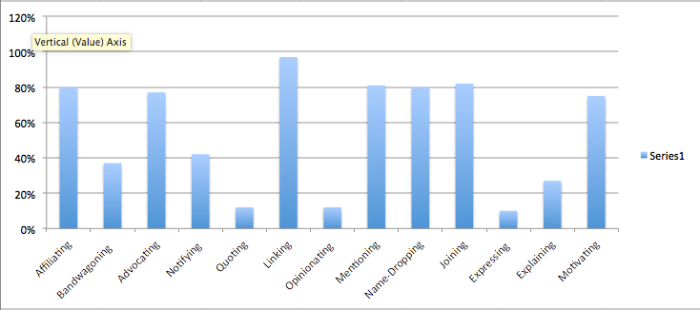
Finding axial codes for these tweets was an interesting task because a lot these tweets are very similar in nature. The people that are drawn to them identify with something in these short sentence and then wish to share it as their own thought. Based on what I saw going on in the open codes I saw more of promoting certain points about the campaign and usage of other peoples status and names to bring attention to this cause. I also saw the usage of images and the linking to other text in order to substantiate their argument. In other words these tweets were “Notifying” followers to certain issue that females like sexual assault on college campuses or in other cases “Expressing” their emotions about how society has taught boys not be honest with their own emotions. These tweets cover a variety of issue and it was interesting seeing the different sides of this complex movement. The spheres that we see at work talk about gender, in some cases boys and in some cases girls and it is unique to see them converge on one platform. What I also notice which is something that I had talked about previously how this organization uses different people like celebrities or political leaders to draw attention to this cause. All of this “Mentioning” and “Affiliating” is really the backbone of a majority of these tweets. The last point I want to make is that many of the tweets might have been retweets about the campaign but this community was tight-knit. There were very few instance of tweets that were completely random and based on all the codes from open to axial the conversation and act of retweeting the information stayed very much so on point.
Selective-Coding:
In he final phase of archiving and then categorizing these tweets I broke them down into 4 main groups that encompasses all the axial codes to better understand the interconnectedness these tweets share. In this phase you are just cross examining each tweet and seeing how this codes have similar attributes that allow themselves to be categorized.
Facilitating
- Affiliating
- Mentioning
- Quoting
- Linking
Promoting
- Advocating
- Bandwagoning
- Name-Dropping
- Joining
- Motivating
Informing
- Notifying
- Explaining
Emoting
- Opinionating
- Expressing
I chose these 4 main topics because I feel that they sum up how this campaign uses Twitter as a whole. Facilitating is all the basic Twitter function that we see when read retweets, so that includes using a hashtag or tagging someone with an @ symbol, I used the words mentioning and affiliating to cover these basic functions. Then some other examples are, quoting, which was seen in a tweet that was retweeted multiple times. Than, finally linking, which allowed people to share content other then the tweet itself.
Because this was an advocacy campaign, I had a whole section called Promoting that dealt with elements that fall under this category. That included advocating which really was any time the mentioned the HeForShe organization, bandwagoning and name-dropping where both techniques used to gain more awareness or promoters by showing others supported the cause or famous did, therefore you should too. Then the next two is this idea that these tweets focused around people becoming a voice for this cause so therefore these tweets motivated you to feel for this cause and then motivated you to join the fight for gender equality. Next, I had Informing which includes any elements of Notifying, where the tweet talked about the going ons of the campaign or directed the viewer to other important news and also explaining about the cause and what they are doing.Then finally because it is an advocacy campaign people tend to voice their own thoughts and feelings so I included the group Emoting where people interjected their own personal beliefs and expressed their thoughts or emotions about the cause.
With these selective codes it was good to show how tweets can have many different meaning and I am sure that if someone else was given these tweets they would have come up very different words or methods in the categorizing of all this information. However despite that we would still arrive to similar conclusion. We would see that these tweets aren’t meant to be conversational because there is very litter interaction between users besides retweeting. The point of these tweets is show the movements of the campaign and gain support. Through all these elements that I have seen in my axial codes and selective codes we can see this happening.
Conclusion
Throughout the whole process of tracking these tweets we delved deeper and deeper into the purpose of all these small amounts of information. They were all originally just thoughts or pieces of whole that led people to investigate for themselves and see a group that has a mission to fight inequality in our world. Before doing this I didn’t really see tweets as a substantial way of measuring how people react or talk about a cause or issue. The reason I thought this way is because these ideas are fleeting, they hit retweet and then they think they are apart of this organization. In my research I realized that they are not and they are.
I can see why people believe that these tweets do not amount to anything substantial because like I said many supporters on Twitter just hit a button and believe they have made a difference. It all depends on how you measure the success of a campaign of this nature. I am sure that using Twitter and people retweeting information as led to many active supporters (aka people who go out and try a make a difference with gender equality). But I am sure this campaign has led to many inactive supporters, who just voice their opinions over Twitter and leave it at that. To people who say that the inactive supports shouldn’t be seen as a driving force for gender equality, I say you are wrong because they are still showing their support and becoming an advocate no matter what. You will always have people who believe in something stronger then other, but with causes such as these every voice matters.
They are in a sense because they are showing their support and just because they are showing it online does not mean that it amounts to nothing. In my generation I have seen governments been toppled by the use of social media and elections have been swayed by peoples constant bombardment of information on the internet. The point is these tweets all though small do matter. It is when campaign such as HeForShe successfully show that they are dedicated to their cause and attract other who believe the same allow for the organization to grow, spread their message, and make a difference.
Whether some people like or not this how 21st century people communicate their ideas. It is no longer through hand written letters or lengthy essays. We use 140 characters messages to bring awareness to whatever we are doing in our lives to the people around use. Therefore, we must figure out ways to quantify and study what people are saying over platforms such as Twitter. People are building relationships and creating communities despite maybe being in totally different states or countries. Therefore based on these shifts in how people interact I believe that the belief that organizations like the HeForShe campaign is a direct result of these changes in what a community can be. Now more then ever people have the opportunity to learn and read about issues that might be plaguing their society but lack a group that advocates for them, because Twitter is not limited by distance these groups have the ability to find more supporters and make a difference in these places that would otherwise be out of reach or un heard of.
Visualizations of HeForShe
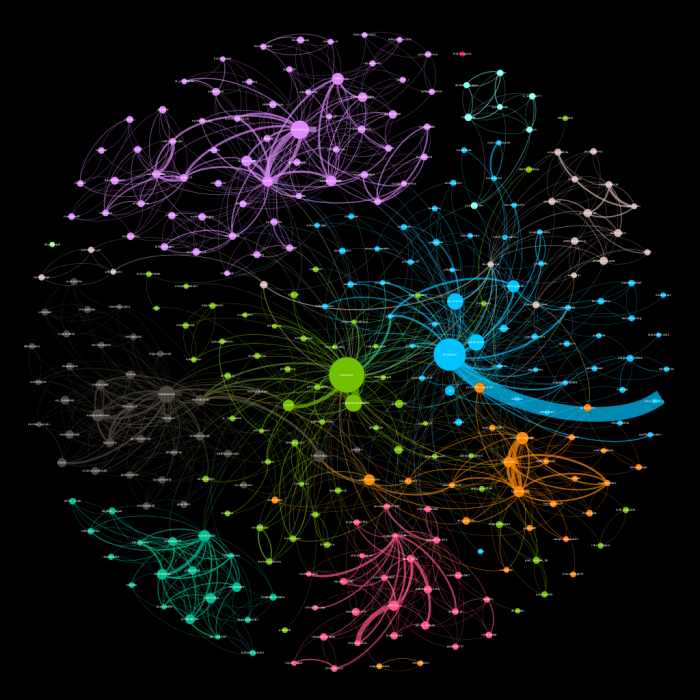
Fruchterman Reingold model seen above
In the last part of our semester long study of the #HeforShe we then put the tweets that we had archived into a program known as Gephi to create unique visualizations like the on you see above. The Fruchterman Reingold model shows all the many different networks within a larger system. What makes these models uniques is how the groups form and connect to one another just by looking at this one hashtag. Along with creating this model we created three others and will discuss what exactly these networks are. From the tweets that we archived we can create In-Degree, Out-Degree, and Co-Hashtag visuals using the same program.
In-Degree Visual:
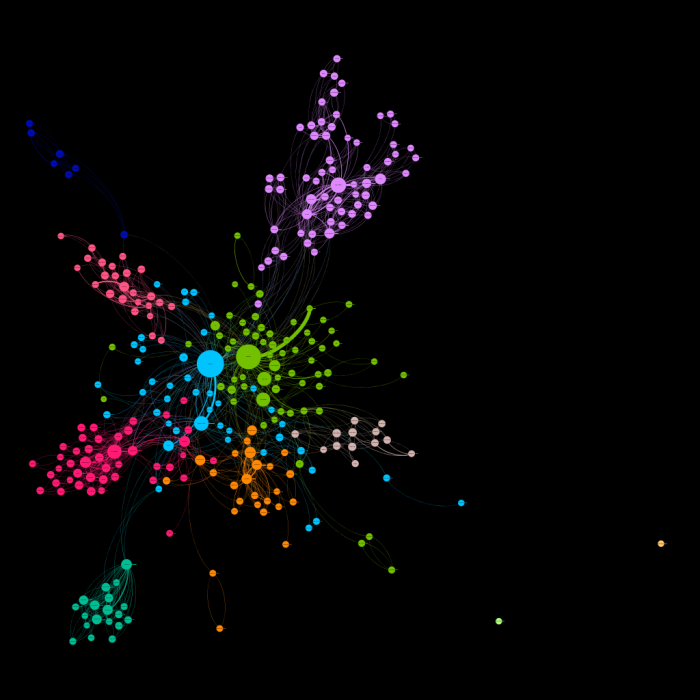
In the network map above we can see many connections being made between each node. The in-degree shows us using different node size, that that user is receiving a large portion of mentions and retweets from other users. That means people are using the @ symbol to bring attention to the main twitter user, which in this case is the HeForShe twitter handle. The blue is the He for She user and then next to it which is just as equal as in size is He for She global ambassador is Emma Watson’s twitter @emwatson, which is in green. These two figures are directing the conversation and the different communities that are related to these groups. Other key figures in this map is the Prime Minister of Canada Justin Trudeau, by whom was mentioned most of the time with He For She and hispanic actor Edgar Ramirez. Many of the other groups and organizations mentioned with He For She was UNICEF, Womened, and Women UN.
In-Degree Subgroup:
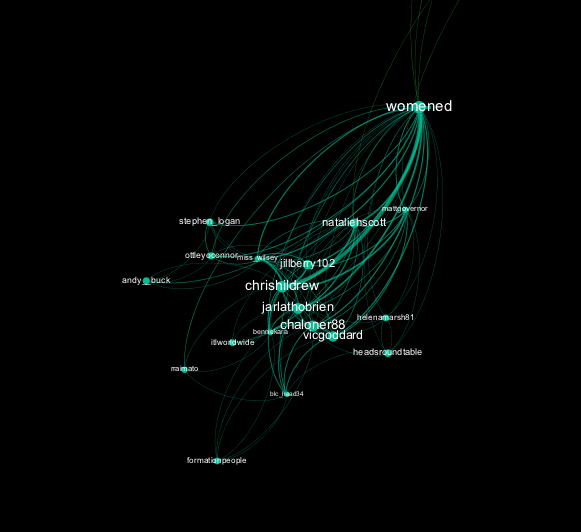
This is an example of a of a subgroup that stems out of the larger map. In this network map there were several subgroups that had connected to He For She by retweeting their content or mentioning them in some way. As we can the main node in this subgroup is the twitter user @WomenED. Their mission is very similar to He For She’s, however it mainly focuses on women coming together to help girls get access to education. As we can see there are many edges stemming from each and every node showing how interconnected this subgroup truly is. This pattern is similar to the other subgroups in the in-degree as well as the out degree maps.
Out-Degree Visual:

The next map we are able to dissect visually is the out-degree visualization. Here we can see how many tweets the users send out using the hashtag and what else they are mentioning. Whether that be through a reply or just tweeting information the edges show us which users are sending out the most tweets compared to who is receiving them. What is very interesting is that in the center we can Emma Watson’s node shrink considerably. She was very prominent figure in the in-degree map getting a ton of mentions. But in the out-degree she does not compare to some of the nodes even in some of outer the subgroups.
Co-Hashtag Visual:
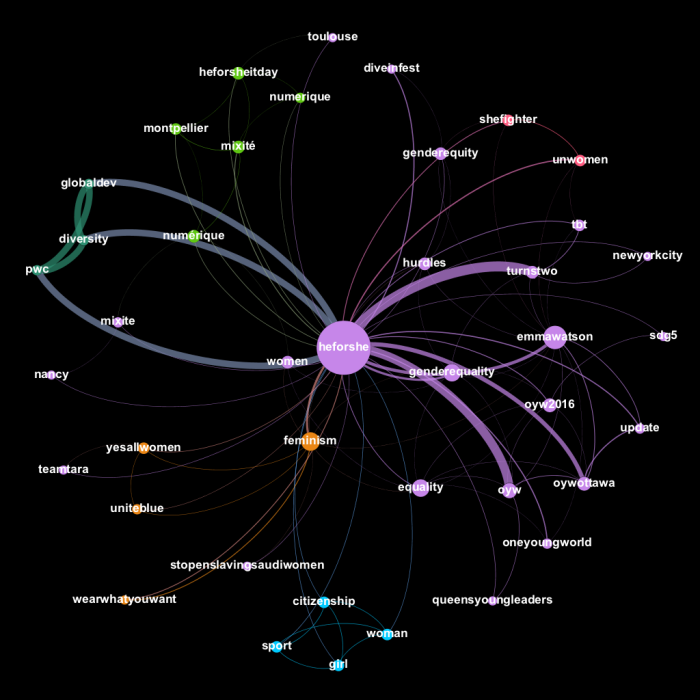
The final visualization we made from studying the He For She campaign and it hashtag is the co-hashtag network map. This shows us the other hashtag that were used when users used the He For She hashtag in the same tweet as one of these hashtags. Many of these hashtags like #emmawatson, #turnstwo, and #genderequality were some pieces of tweets that were coded when that step was taking place earlier on in this study. These connections show us the affiliations this campaign has made and how its message for gender equality and equity are synonymously used with the #heforshe.
When also looking at the co-hashtag visual it is important to understand the different modularity communities within this network. When making the visualization a total of six distinct communities came out of the tweets that I have archived.
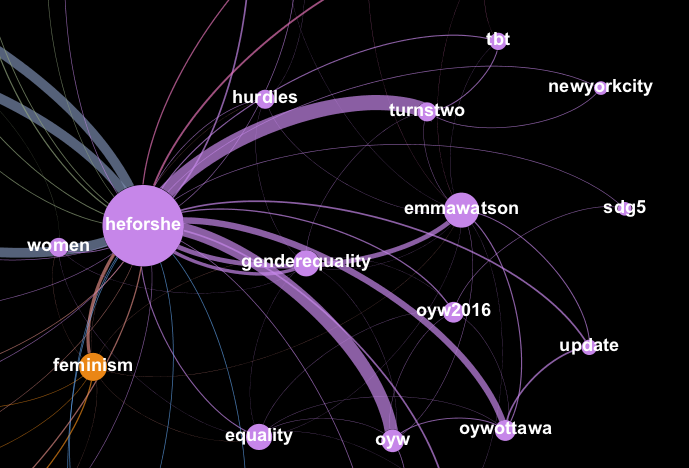
The community that I believe stands out the most is larger purple that incorporated the main hashtag is also apart of. I also chose this community out of the six because a majority of these hashtags look familiar to me when I was doing my coding. Some of those include #genderequality, #equality, #emmawatson, #turnstwo, and #women. Some of these hashtags I even had coded in the coding portion of the study. The other ones that seem to be grouped together are all the ones that have #oyw in them. This is referring to the organization One Young World which had held a summit in Ottawa, Canada about being young leaders in their countries. As we can tell from the hashtags used gender equality was a large portion of the summit and the He For She campaign had a role in the summit as well. The other interesting hashtag was the #update node, which shows an element of live tweeting going on around this time. What is interesting about this modularity is that just by looking at these hashtags we are able to decipher events, times and places where these tweets had taken place. They become an virtual archive that we can then study ands see the importance of summits like these and their impact on virtual and physical world.
Final Infographic and Reflection
Tweets of my Infographic:
I tweeted my infographic to the two main users who used the He for She hashtag the most and one that would gain the most attention. They are @HeforShe and @EmmaWatson the He for She ambassador.
With the semester coming to a close and so is the He For She hashtag study the portion of the study was to create and infographic using all the information that I have collected from our hashtags. This includes thinking about the tweets and the users that I had seen over this six month period and condensing it into an easy to read format. Using the website Canva which helps make creating infographic easy was very useful. The main thing that I wanted to get across with my graphic is the essence of the He For She campaign. I wanted it to look professional and be able to be easily related to He for She. I used images that were allowed to be modified, that were open sourced. I thought that the black and white made the images more dramatic and the main image really draws the viewer in. The point the graphic is three main parts. First the header that is obvious and apparent to the viewer about what this is for. Secondly a very brief summary about the study and the infographic, paired with three images of children and school with the processes that my study went through. Lastly a look at the visualizations that I made showing all the different communities involved with this hashtag. I give small bits of text to explain these images along with arrows to direct the views attention. Overall Canva was a interesting website that gave me the opportunity to put all the information I learned in a visual tool.
The main goal of my infographic was that to show all the subgroups that are linked to this hashtag. I may or may not have accomplished this because I did show the groups but they are somewhat hard to identify on these maps. I really wanted to show the progress of the study but also use images as much as I could. By showing all the different networks linked to this hashtag I hoped to show how popular this campaign is and how much people really do care about this issue. It was somewhat hard to show all the groups connected and go into detail about the groups affiliated with this cause. The infographic portion was culmination of all that we have done, it differs from the study pages because it is a visual summary of all that we have done. It is text limiting therefore it makes you tell the story and explain the issues in a different way. The approach to this graphic is different because it is suppose to draw the viewer in and inform them on a particular matter. My matter happen to be the hashtag study on He for She along with the communities surrounding it. These communities vary in size and geographical location but all tweet about the same thing which is the fight for gender equality.
Looking back at the what I have made actually made me very proud of myself. Some of the archiving and coding was a little bit tedious but the reward outweighed those parts of the study. The reward being seeing these communities almost come to life and all the connections that people across the world have made for one issue that is so important to society to understand. I like the progression of archiving, the coding and then using the data to create an end result which was the visuals and then the infographic. Like I had mentioned I feel as if it was all very professional work that could be useful in the future. The other thing that I enjoyed was how hands on it was and how many of the design choices were up to me to make in order to make something interesting. In the end for someone like me who doesn’t necessarily use Twitter this was by far one of the most interesting studies that I have every done by myself.